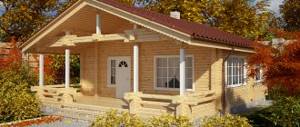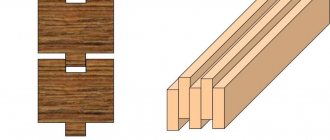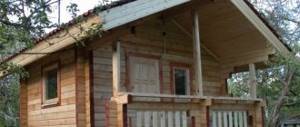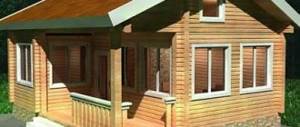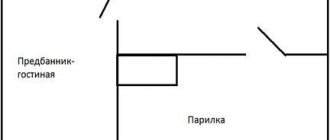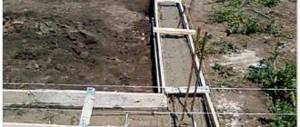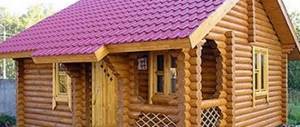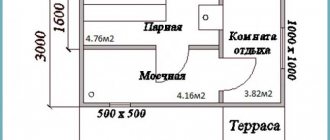The Russian bathhouse has a lot of advantages When it comes to building a bathhouse, it is difficult to choose the material from which it should be. Traditionally, a bathhouse is assembled from wood, but modern lumber has made it possible to choose. What is the best bathhouse, pros and cons of timber, logs and panel. Which is better, Russian or Turkish Hamam? Or maybe build a bathhouse out of bricks or blocks? Let's try to figure this out together with our readers.
Baths made of planed timber
Among the main types of timber are the following:
- non-profiled: classic timber, which is made from solid wood, has smooth edges;
- profiled: the edges have special grooves that connect to a similar beam;
- carriage or half-beam - two opposite sides are cut from the log, and the rest remain semicircular;
- laminated veneer lumber is a load-bearing structure that is 50-70 percent stronger than solid wood.
A bathhouse made of timber is made from solid wood by sawing. This material is used most often for the construction of baths. The diameter of the logs is from 150 to 250 mm, softwood is used. Among the most popular are pine, larch, fir, and cedar. Hardwoods can also be used: oak, birch, aspen, linden.
Among the main advantages are:
- availability;
- affordable cost;
- storage of the form, which avoids shrinkage, cracks and other wood defects;
- environmental friendliness;
- resistance to temperature changes and exposure to sunlight;
- high resistance to moisture, good thermal insulation properties;
- wide functionality: timber can be used for load-bearing structural elements.
The disadvantages of the products are:
- the possibility of cracks appearing on the visible surface of the timber during shrinkage;
- it is necessary to cover the walls outside and inside, and this increases the cost of finishing work;
- the structure can experience serious shrinkage - up to 10-15 cm.
When choosing such structures, you should pay attention to the humidity level. It is advisable to use only timber that is dried in a heat chamber.
What types can be found on sale?
Woodworking products are very diverse, and the timber we are interested in has many options for shape, cross-section, type of used , etc.
Form
The name of the subtitle is very arbitrary, because we will talk about processing methods, the shape, and the composition of the timber. But first things first.
Unplaned
If you cut off the “humps” (croaker) from a log on four sides, then the round cross-section will become square.
Actually, this is how the timber is made - using a saw (circular or band saw). However, the saw leaves a very rough surface that could be made smoother by planing, but this is an additional operation that increases the cost of the lumber. And here at the exit we have the cheapest timber , which has not been processed with anything other than a saw.
The only attractive thing about this type of timber is the price. Without additional finishing inside and out, it looks rather unaesthetic, so in its pure form it is used for outbuildings (if the cross-section is small), but for a bathhouse such timber is suitable if it is thicker, and it is also advisable to put insulation between it and the interior decoration.
ADVICE! Unplaned timber has natural moisture, that is, it has been subjected to atmospheric drying. Such timber is often subject to deformation - bending or twisting; be picky when choosing the material.
In addition, it is necessary to mention the shrinkage of a structure made of unplaned timber - like a building made of logs, it must settle for some time. The minimum is six months, although this is not serious. Optimally – a year before the start of the first finishing work.
Profiled
Another candidate for bathhouse timber is profiled timber. What it is? This is a much better and higher quality processed material, which has a specific profile along the top and bottom - protrusions and recesses, which, when combined, increase the adhesion of the crowns, reduce the possibility of moisture penetrating into the inter-crown space, in general, it is more useful than a smooth surface.
Shrinkage of this type of timber also occurs, but some argue that it is less. We believe that shrinkage can actually be less only in the case of thermal (including chamber) drying. But we'll talk about humidity later.
The profile sections of such timber can be very different. But if we consider the protrusions and recesses as a tongue-and-groove connection, then, depending on the thickness of the timber, there may be one or several. It all depends on the manufacturer. Some limit themselves to two, regardless of the thickness of the timber; others turn the joint into a “comb” of many protrusions.
Another nuance of profiled timber is the possible presence of a chamfer - a removed corner that visually separates the crowns.
The profiled itself can be planed from a single log or glued, but the profile shape of both may well be identical. Or maybe not.
Glued laminated timber for a bath
We must understand that there is a well-founded technical, and not just an economic reason, why the timber is assembled with glue. It's all about the tendency of wood to turn out, twist, bend and crack during natural drying . This happens for two reasons - uneven shrinkage of the surface and deep layers and residual stress in the fibers themselves.
And the appearance of deformations has its own logic - depending on how the wood fibers are arranged, the timber from it will curl in a certain direction. If you take and glue two boards with opposite bending directions, they will compensate for each other’s deformation, and the double beam will remain even.
IMPORTANT! Properly located pieces of wood relative to each other when gluing are able to completely compensate for internal stresses in each individual element.
As for the technology, it involves high-quality drying of the parts to be glued, as well as the use of a press for the future strength of the adhesive joint. As an analogy, we can cite the principles of creating plywood from veneer - the only difference is in the thickness of the lamellas.
Another advantage is the fact that areas with flaws are not used . So the buyer receives high-quality wood, well-dried, which significantly reduces the time and extent of shrinkage , and is also not prone to deformation .
Double beam
The double beam is not such a recent invention. This is a completely independent lumber, or rather it would probably be more accurate to say that this is a certain structure made of boards, designed to improve the thermal insulation characteristics of wooden walls.
Since this structure looks indistinguishable from ordinary planed or laminated timber in the wall, it is usually called “double timber”. But technically this is a misnomer, because the minimum dimensions of lumber that claims to be called “timber” is 100x100 mm.
Strictly speaking, we are dealing with tongue-and-groove boards laid parallel to form a cavity into which insulation can be placed. This forms the basis of the design, and the manufacturer varies the height, thickness of the boards, as well as the device for their mutual connection.
Ecowool is standardly used as insulation laid between the boards - a good thermal insulation material made from waste paper impregnated with fire retardants and antiseptics, which makes it resistant to both fire and the effects of bacteria, fungi, insects and rodents.
INTERESTING! Glued laminated timber retains heat one and a half times worse than double laminated timber of the same size. This information can be found in SNiP II-3-79.
In general, a bathhouse under a double beam is an option worthy of consideration. However, it is worth understanding that standard insulation methods are also time-tested and work no less reliably. We mean the usual insulation of premises from the inside.
A little about shrinkage. Everything always depends on the method of drying the timber. Some manufacturers offer chamber-dried boards, which, on the one hand, increases the cost, and on the other hand, eliminates further problems with shrinkage, because thermally dried timber no longer loses moisture and, therefore, does not change its dimensions by more than 2%, and does not crack, which is also important during operation.
Construction time is reduced because standing is not necessary, and laying the walls itself does not take much time. It’s also good that additional work on wall insulation is no longer necessary.
ATTENTION! Good news for those who have an idea about caulking log buildings - if you use double timber, it is not needed!
Section type and size
There are two main types of sections that can be found on sale - square and rectangular. The first is more typical. With the advent of profiled timber, a third type appeared - a complex section. As mentioned above, there is no standard for this complex section, so each manufacturer independently chooses the size, shape and number of teeth and grooves on the connecting sides.
Section sizes can be very different, but most are built from standard ones: 100x100, 150x150 or 200x200.
Humidity
Wood moisture content is an indicator that affects the time and amount of shrinkage of the finished building frame, and also indirectly affects the deformation of wood if drying was carried out incorrectly (although even if it was dried correctly there is always a certain percentage of defects).
It is measured as the ratio of the mass of water to the mass of wet or dry wood, in the first case the relative humidity is obtained, in the second - absolute humidity. Measurements of this kind are carried out in laboratories. Therefore, the buyer is left with two options: take the seller’s word for it or arm yourself with an electric or ultrasonic moisture meter.
In turn, the woodworking industry has developed a classification that distinguishes the following categories:
- wet – wood after rafting, has a moisture content of more than 100%;
- freshly chopped – its humidity is from 50 to 100%;
- after atmospheric drying – humidity is in the range of 15-20%;
- after room drying – humidity in the range from 8 to 12%;
- heat-treated - from 3 to 5%.
IMPORTANT! Normalized humidity after drying is generally considered to be 12%.
A tree is one of the complex forms of life; all its parts consist of cells with different specializations. The moisture that is inside the tree can be free and simply flow through the vessels, or it can be bound, that is, part of the cells.
Free moisture evaporates first and does not affect the dimensions of the wood product. Bound moisture leaves much more difficult, and after its removal the tree becomes lighter, and its volume and linear dimensions in the radial direction also decrease.
It is interesting that if you achieve almost complete disappearance of bound moisture, the wood changes its properties . It greatly reduces the ability to absorb moisture and change dimensions, and it acquires special strength, flexibility and hardness. But all these miracles are possible only with high-temperature drying, when the temperature reaches 103±2 degrees.
During atmospheric drying, moisture leaves the wood unevenly, resulting in a difference in humidity between layers. Because of this unevenness, tensile and compressive stresses arise, which disappear only if it is possible to equalize the moisture content throughout the entire thickness of the lumber. This is called “proper drying”. If this is not done, we will end up with variously bent and inverted lumber.
Such essential indicators of wood as density and thermal conductivity also depend on humidity.
Wood
Since we believe that understanding is the basis of the right choice, we will tell you in more detail about the characteristics of wood mentioned above, and also briefly about the species from which timber can be used for a bathhouse.
General characteristics: density, thermal conductivity, etc.
Wood is a material whose characteristics are strongly interconnected, due to which a change in one parameter leads to a change in all the others.
The main variable parameter is humidity. In addition to the fact that wood has its own moisture - bound and free - it can also take water vapor from the surrounding space, and release it when the temperature rises.
Wood that gains moisture becomes larger in volume, its flexibility (flexural strength) increases, and thermal conductivity increases.
Accordingly, dry wood has a smaller volume, is harder, less flexible, and has lower thermal conductivity.
Let us clarify that thermal conductivity is the amount of thermal energy that a given material is able to transfer through itself from the heated part to the cold part (metals are excellent conductors of heat, but foam conducts it very poorly). This characteristic differs from heat capacity - the ability to retain heat inside a material.
BY THE WAY! The thermal conductivity of wood depends on the direction of the fibers: along the length of the fiber it is higher than in the transverse direction.
Density is the ratio of mass to volume. The smaller the mass and the larger the volume, the lower the thermal conductivity of this type of wood. One of the hidden factors is the presence of voids in the wood tissue. Abashi oak is valuable because it has very low thermal conductivity, that is, it does not heat up. This is due to its low density.
The higher the density, the greater the weight and the greater the hardness. In some cases, this is very good - larch and oak are dense and hard, and successfully resist the effects of water and do not rot.
Strength is measured in three ways - bending, compressive and tensile. However, we are talking about which timber is best to choose for a bathhouse, and for wall material, only the compressive strength can be taken into account in some engineering calculations
Here is an example of the relationship between various characteristics. Ideally, the material should comply with SNiP standards.
If you know the type of wood and its moisture content, for example, you can always look up the standard values of its other characteristics in reference and technical literature.
Aspen timber for a bath
There is one curious paradox associated with aspen: on the one hand, this tree is not afraid of moisture, because it grows in swamps, and on the other hand, it has low resistance to rotting - approximately at the level of linden.
Perhaps the contradiction will be resolved if we assume that the tree is not afraid of water, and rotting is caused not by water, but by bacteria, and it is against them that aspen is defenseless.
Aspen timber for a bathhouse is a good solution for a steam room and washing room , provided that you managed to find high-quality material without rot, and you treated it with compounds containing antiseptics developed specifically for saunas - the Finns have this.
You can read more about the characteristics of timber for an aspen bath in the article, which is entirely devoted to considering its characteristics, advantages and disadvantages.
Linden
Photo: bath door (linden)
Another favorite of bathhouse builders. Despite the fact that the wood of this tree is very soft and not resistant to rotting , it has one almost miraculous property - when wet, it does not swell and does not stain.
Therefore, the best use for linden is still frames, doors, jambs, that is, elements for which it is important to maintain linear dimensions. But it is also often used as interior decoration - linden lining, which has a pleasant, subtle smell, is highly valued.
Shelves and are also made from linden . You can read more about doors made of linden, and about lining made from it, and about shelves (and about furniture in general), as well as impregnations for shelves - these are all separate articles, but there is also a summary material where we talk about its use in the bathhouse in general.
Oak
Everyone loves oak in a bathhouse, except for one thing – the price is steep. Therefore, those who would like to take advantage of its resistance to moisture in the bath usually make only the lower crowns from it. Because it is this part that usually suffers most from the external and internal effects of water.
The most famous other distinctive features of oak lumber are hardness, high density, strength, resistance to rotting and fungal infections. And of course, the beauty of the texture.
Abashi oak is the most valued in the bathhouse - this one, on the contrary, is characterized by extremely low density. An abashi log can be easily carried by one person. The wood of this oak is used to make shelves and backs behind shelves, because people appreciate its low thermal conductivity, thanks to which there is no risk of getting burned even in an overheated sauna. They also make lining from it, but it is not cheap.
You can learn more about the properties of abashi oak and its use in the bathhouse from this article.
Pine
Pine timber is one of the cheapest, and therefore most popular materials for bathhouse construction. Although its properties only partly contribute to this.
Like any coniferous tree, pine contains resin. This is an advantage and a disadvantage. As an advantage, it is worth considering the fact that the resin prevents the wood from rotting and makes it more resistant to moisture. And this applies to all conifers. The disadvantage is that as the temperature rises, the tree begins to ooze resin, which is located inside large and small vessels in the wood tissue.
Resin leaks on coniferous wood
The resin released in the steam room can cause burns. Therefore, there are two options to solve this problem:
- or lay out the walls of the steam room with hardwood timber;
- or make the interior lining of the steam room with hardwood clapboard.
As you can see, coniferous walls in a steam room are in no way desirable. As for the pine bathhouse, here you will find a lot of interesting and useful things.
Spruce
Wood, in many ways similar to pine, but looser, that is, spruce has less density, and timber made from it is lighter.
The disadvantage of spruce compared to pine is the fact that it absorbs more moisture than pine.
In terms of price, they are almost or completely the same.
Larch
If we call the leader among the species that are offered for baths, then larch may well lay claim to this title.
Its main advantage is that it only gets stronger from moisture. You can safely pour water on it. However, one should not elevate such statements to absolutes, because both quality and circumstances vary, and even larch can rot. This does not in any way cancel the fact that it was its wood that was traditionally used where constant contact of wood with water was required.
In terms of hardness , it is quite comparable to oak and is just as difficult to process.
about resin - in fact, larch tissues contain even more resin than pine, but bathhouse owners claim that it does not protrude to the surface, even if the steam room is lined with larch clapboard.
Cedar
Cedar pine is another often recommended material for building a bathhouse, but with the same adjustment for high cost.
What is curious is that here the rule regarding the undesirability of conifers in the steam room is violated. Cedar lining for finishing, for example. And the cedar beam here looks like the ultimate dream.
On our website there is a separate material about a cedar bathhouse and another one about a mobile version of a bathhouse - a barrel made of cedar planks.
Profiled timber
Profiled timber is very popular today because it has precise geometry. To assemble a bathhouse from such material, it will take only a few days, because the timber fits perfectly together. Due to the design features, the ingress of water inside is minimized, so rotting of the wood is excluded.
Among the main advantages of the designs are:
- high speed of construction work, several weeks are enough to build a bathhouse;
- wonderful appearance: correct shape, smooth surface, perfectly smooth walls;
- high environmental friendliness, a whole array of wood without synthetic elements is used to assemble the bathhouse;
- practicality, the structure can be disassembled and rearranged to a new location;
- the material does not require cladding, which reduces construction costs.
The main disadvantage of profiled timber is the large technological interruption in construction for shrinkage of the house. The timber must dry well; before finishing the timber you must wait 10-12 months. After some time, cracks appear in the profiled timber.
“Disadvantage” No. 1: Sapwood is a protective layer of wood
Adherents of hand-cutting say that the shortcomings and disadvantages of rounded logs are already visible in production, during which the sapwood, the most important protective layer, is removed.
In fact, sapwood is the younger layers of the tree; bast and bark are adjacent to them. Let's figure out what this “strongest and most important layer” is. According to Wikipedia, the resource that is the most important primary source of knowledge of our time, it is lighter than the inner part of the log and is characterized by less mechanical strength. It contains more water, since water is transported to the crown through it, and is less resistant to attacks by fungi and insects.
#BXSTYLE_0#
The authors of the Great Soviet Encyclopedia share the same opinion, which also states that sapwood is less dense due to its role as a transport hub for water to the crown. In construction, it is believed that this part will deteriorate and wear out faster due to fungal rot or mechanical stress. In summer, pine sapwood becomes blue-black or green, and the same color penetrates to the beginning of the core. This phenomenon occurs due to the influence of staining fungi. These fungi do not spoil absolutely anything in the tree except its appearance, and they feed on substances that are present in the sapwood
How then is it possible for a less stable layer of wood to protect a more durable one?
Now let's go backwards. The most interesting thing is that adherents of this myth of deficiency say that this is precisely the most durable layer. Then timber (profiled and glued), as well as a number of other building materials, are no good at all. In this case, it turns out that all the coverings must be made of logs: frames for doors and windows, sheathing and rafters, and most importantly, work with an ax.
By logical argument, we can say that for rounded logs, the removal of sapwood is not a disadvantage. On the contrary, removing young layers reduces the risk of rotting.
And to finally refute the disadvantages of rounded logs regarding production, imagine that you are the owner of such a production. You have purchased raw materials with a diameter from 220 to 330 mm, about 2500 cubic meters. Fans of hand-cutting say that when removing sapwood, 30 or even 40% of the diameter of the log is removed. Then it turns out that at the output we get OCB with a diameter of 200 - 240 mm, and in cubic capacity we get 1500 cubic meters. The cost of such production of one cubic meter will be 10,000 rubles. As a result, it turns out that production is unprofitable, because the average selling price of rounded logs per cubic meter is 7000-7500 rubles and no one will work at a loss, this is obvious. Traditional processing from 2500 cubic meters. produces 2300 cubic meters. processed material. Due to the fact that the wood is sorted by diameter, only 1-3 cm is removed.
Rounded and whole log
Classic baths are made of round timber; it is manufactured using equipment with a high degree of precision. In addition, a log of the correct geometric shape and the same thickness is produced. The material allows you to additionally insulate the inter-crown space, while shrinkage does not occur.
The main advantages of such devices:
- high technological level;
- simple and convenient assembly;
- environmental friendliness;
- natural wood is used;
- durability, strength;
- high aesthetics.
Minuses:
- shrinkage lasts from 6 months to a year.
A bathhouse made from a solid log is very expensive when compared to maple timber. The structure will last a long time, the appearance of the bathhouse retains the authenticity of a traditional Russian bathhouse. A bathhouse made of timber has less load on the foundation.
The structure requires periodic maintenance; it is advisable to impregnate the structures with liquids from fungus, mold and bugs. The products have increased fire resistance, so water-repellent impregnations and antiseptics are necessary.
A wooden bathhouse made from a log house is absolutely environmentally friendly for health. The wooden house is original and beautiful, the wood grain pattern gives the structure a great look.
Advantages and disadvantages during construction
timber
Bathhouse made of laminated veneer lumber
Deadlines. To build a log bathhouse from timber, it takes from 2 to 7 weeks. These are average statistics for a neat small bathhouse. The start-up period after assembly of the building depends on humidity.
Shrinkage. Depends on the material. Glued gives the smallest (1-2%). Profiled and dried, up to 5%, with natural humidity, up to 10%;
Labor intensive. When using profile timber, there is an option to build the “desired house” yourself, without involving competent builders. Well, let’s say in a company of 3 people, plus the necessary tools and available mechanisms.
Finishing. Again, it depends on the type of timber. If you use a profiled one, finishing is generally not needed. If you build it from ordinary non-core material, you will have to spend money not only on finishing, but also on caulking.
Log
Deadlines. With similar dimensions, a log bathhouse can be built in the same time. This is provided that the logs are already ready. However, you will have to wait about a year for the “ribbon cutting” with a broom under your arm.
Shrinkage. On average, over a year, the log house will “sag” by 8 - 12%
Labor intensive. It is not easy to build a bathhouse without qualified builders or an experienced consultant. There are moments, ignorance of which leads to bad consequences.
Finishing. You need caulking (more than once) plus sanding.
Panel baths
Panel baths are a budget option for a ready-made bath that can be built in a short time. Such structures are lightweight and are installed on an economical columnar foundation. The material must be treated with an antiseptic to protect against mold, rot and fungi. A panel bath built using the correct technology can be used at any time of the year. The bathhouse box should be mounted from separate panels, and the structure is non-monolithic. To build a frame-panel bathhouse, high-quality heat, steam, and waterproofing is required. To reduce high humidity, you will need to install waterproofing. To insulate the foundation and floor, you need enhanced thermal insulation of the walls.
Main advantages:
- When building a frame-panel bathhouse, it is not labor-intensive and quick; the bathhouse will be ready in a few weeks. It will take 2-3 weeks to insulate the frame and other work.
- This method of construction is affordable, since it involves the use of a standard design, inexpensive materials, and a lightweight foundation.
- Various materials are used to decorate the baths; panel baths are heated well.
- Since the structure of the bathhouse is lightweight, it does not require long-term shrinkage.
- A bathhouse can be made from completely different materials with completely different technological characteristics.
The disadvantage of the design is its short service life - 10-15 years.
What to choose: which one is better? Video
We found a video from the owner of a construction company who shows a bath house that he is building for himself. There he talks a little about the benefits of the choice he made:
Well, a few tips (some of them are questionable from our point of view) in this video:
Regarding the benefits of winter wood: we advise you to look through reference books, where numbers prove that the moisture content of coniferous wood in winter is higher than in summer.
*** We invite you to share your opinion with the owners of bathhouses already built from timber - what advantages and disadvantages were discovered during operation? We think this will be of interest to all readers.
Main comparative characteristics
Let's consider what is better to use for construction: timber or logs. The core of solid logs has excellent protection from atmospheric and weather conditions. It is best to use timber that lacks reliable protection.
The shrinkage of a log house made from logs is 10-12 cm, and from timber – 6-10 cm. Building a bathhouse using timber is much easier than using logs. For the construction of log baths, they are not subject to hygroscopicity.
When drying, the logs crack vertically, the timber can crack in a chaotic manner, so the cracks can have an unpredictable direction. In order for a bathhouse built from timber to serve for a long time, it is necessary to comply with technical operational measures.
How to choose the right material for building a future bathhouse?
Timber wall construction.
Of course, each of you will independently choose the material for building a bathhouse. But you definitely need to know about the nuances of timber and logs in order to ultimately make the right decision.
The first thing to say is that both materials have several varieties. So, for example, timber can be glued and regular, non-profiled and profiled.
In addition, this material differs in the degree of humidity, which, in turn, has a significant impact on the properties of the timber as a whole. As for logs, they are rounded and hewn by hand.
Based on all that has been said, we can say with confidence that there is no clear answer to the question we posed, because the materials differ greatly from each other.
